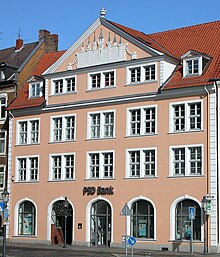House of the Seven Towers
The House of the Seven Towers is a baroque residential building that belongs to the ensemble of the old town market in Braunschweig .
The name "House of the Seven Towers" or "The Seven Towers" for the building at Altstadtmarkt 11 has been used since 1294.
The representation of the Seven Towers is not about Braunschweig, but rather the representation of the " Prison of the Seven Towers " in Constantinople . The baroque representation makes use of the allegory of the crescents, although Constantinople was not yet Muslim at the time of the underlying event. According to one of the many legends about Henry the Lion , a companion of Henry the Lion whose name was unknown is said to have been imprisoned in the "prison of the seven towers" on the pilgrimage to the Holy Land in Constantinople in 1172. "If I ever get out, I'll build a house with seven towers," was his pledge.
In the middle of the 14th century, the building belonged to the von Damm patrician family from Braunschweig. In 1374, the “ Great Shift ”, a bloody guild revolt against the council of the old town , broke out in the neighboring Schuhhof . In the course of this shift, the then house owner and mayor of the old town Tile von Damm was executed on April 19, 1374 on the Hagenmarkt and his house was looted and set on fire. The front of today's house was built in 1708, the executive architect is said to have been Hermann Korb . The building was repaired after war damage after 1945 and completely renovated in 1996.
Web links
Individual evidence
- ^ Günter Jahn: The old town market in Braunschweig - history and stories , in: City archive and public library Braunschweig. Small writings No. 18 , edited by Wolf-Dieter Schuegraf, on behalf of the city of Braunschweig, 2nd edition, Braunschweig 1998, p. 17
Coordinates: 52 ° 15 ′ 47 ″ N , 10 ° 31 ′ 5 ″ E


